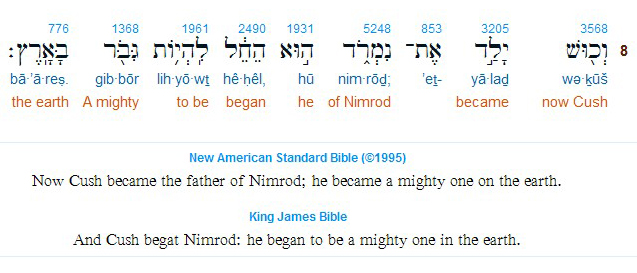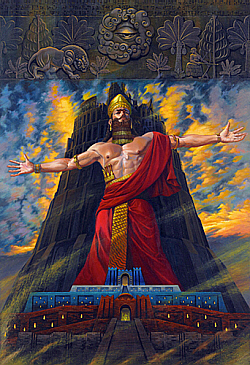Genesis 6 Experiment
“As it was in the days of Noah, so shall it be at the coming of the Son of Man.” – Jesus Christ, 33 AD
A Study by Rob Skiba: Seedtheseries.com
When human beings began to increase in number on the earth and daughters were born to them, the sons of God saw that the daughters of humans were beautiful, and they married any of them they chose… The Nephilim were on the earth in those days—and also afterward—when the sons of God went to the daughters of humans and had children by them. They were the heroes of old, men of renown. – Genesis 6
This passage of scripture describes what I call, “The Genesis Six Experiment.” The beginning of that chapter tells the reason why God decided to destroy the world with a Great Flood. It says that angels of God mated with women and created super-human hybrids called the Nephilim. These creatures corrupted the whole earth.
Before I can go any further, I must first stop here for a moment and correct some common misconceptions often associated with this passage of Scripture and address the following question. How do we know that this passage is talking about angels? I’ve run into this “debate” on more than a few occasions whenever I’ve brought this subject up in church. The debate comes from a line of thought (taught in many seminaries) that the term, “sons of God” is a reference to the children of Adam’s son, Seth and that the “daughters of men” is a reference to the children of Adam’s (bad) son, Cain. This type of reasoning is flawed on so many levels and I can’t believe it is even still taught! But it is, so I need to address it here.
First of all, how are “Nephilim” (some translations say “giants”) born to normal human beings? If all we are talking about here is the inbreeding of the offspring of two brothers, how does one explain the giants – both before and after the Flood?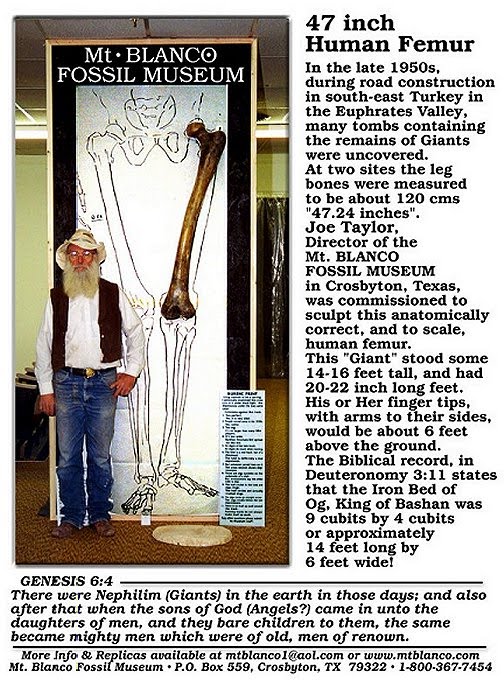
The same scholars who teach this theory don’t seem to have a problem with the biblical account of the giants that the Israelites had to drive out of Canaan. So, how can they accept that characters like Og of Bashan and Goliath of Gath were indeed giants and somehow explain away their genetic traits short of a true reading of Genesis 6:4? I don’t care how much spinach you feed them, normal humans do not give birth to 18 and 12 foot giants!
Second, for those who would call themselves “scholars,” they should have recognized that the words translated here as “sons of God” come from the Hebrew words, “ben” (Strong’s # 1121) and “elohim” (Strong’s # 430).
Strong’s defines “ben” as meaining:
- afflicted, age, anointed one, appointed to, arrow
- From banah; a son (as a builder of the family name), in the widest sense (of literal and figurative relationship, including grandson, subject, nation, quality or condition, etc., )
and “elohim” as:
- angels, exceeding, God, very great, mighty
- Plural of ‘elowahh; gods in the ordinary sense; but specifically used (in the plural thus, especially with the article) of the supreme God; occasionally applied by way of deference to magistrates; and sometimes as a superlative — angels, X exceeding, God (gods)(-dess, -ly), X (very) great, judges, X mighty.
This is the same combination of words used in Job 1:6, Job 2:1 and Job 38:7, each of which are commonly accepted by these same “Sethite” scholars to be in reference to angels. The Job passages describe events taking place in Heaven. They are not talking about Seth’s children hanging out with Satan and the angels for a little meeting. So, why accept the angel view in Job, but disregard that same view in Genesis, when the text clearly indicates that it is referring to the same thing – angels?
Suffice it to say, the “Sethite-Cain view” taught in seminary and perpetuated from pulpits all around the world is inaccurate, flawed and should be completely disregarded! Now, back to our regularly scheduled programming already in progress…
As a result of angels breeding with women, all of God’s creation had been corrupted, distorted, manipulated and changed from its previous state, which God had pronounced, “very good.” There was only one family of humans that had apparently not been affected by these “bad genes” and that of course was Noah and his family.
These are the generations of Noah: Noah was a just man and perfect in his generations, and Noah walked with God. – Genesis 6:9 (KJV)
Scripture says that Noah was “perfect in his generations” which literally meant “pure” as in his genetics. We know this because the word used there is “tamin” (Strong’s # 8549). It is the same word used when the Lord referred to a red heifer that had to be physically pure:
This is a requirement of the law that the LORD has commanded: Tell the Israelites to bring you a red heifer without defect or blemish and that has never been under a yoke. – Numbers 19:2 (NIV)
According the Book of Jasher, Noah married one of Enoch’s daughters. In Genesis 5:24, the Bible tells us that Enoch was so righteous in God’s eyes that He took the man to Heaven without ever having to die.  So, it is reasonable to assume that his daughter certainly would have known the truth and had been a great candidate for Noah to marry. Going with the assumption that Noah and his wife were physically/genetically pure, their three sons, Japheth, Shem and Ham must also have been genetically pure. But that does not necessarily mean their wives were.
So, it is reasonable to assume that his daughter certainly would have known the truth and had been a great candidate for Noah to marry. Going with the assumption that Noah and his wife were physically/genetically pure, their three sons, Japheth, Shem and Ham must also have been genetically pure. But that does not necessarily mean their wives were.
Jasher says that Methuselah had a son named Eliakim who had three daughters. Noah picked them as wives for his three sons. The statement is also made that all but Noah, his family and Methuselah had strayed from God (including Noah’s father Lamech). This being the case, it is reasonable to assume that Eliakim falls into the category of those who had gone the way of evil (since he didn’t make it on the ark), which could imply that his daughters may have become corrupted by “The Genesis Six Experiment.” This would certainly seem to explain how the giants appeared “after that” (that meaning the Flood).
I believe the Biblical account proves that at least one of the wives of Noah’s sons had Nephilim blood running through her veins. That one was Ham’s wife. I say that because his lineage is literally loaded with giants! I don’t really see evidence in Shem or in Japeth’s lineage, but of the four sons of Ham, at least three appeared to have produced giants… and lots of them!
In Genesis 10, we read that Ham had Cush, Mizriam, Phut and Canaan. Since the Bible mentions Canaan first (in Genesis 9), let’s start with him and work our way backward.
I have a theory about Canaan based on the strange situation described in Genesis 9:20-25. In that passage of Scripture, Ham finds his father naked and Noah curses his grandson, Canaan. Why? Scripture is silent, but I suspect it was because there was something obviously wrong with him.
First of all, the narrative implies that Canaan had to have been there for Noah to have cursed him. That means he was either born on the ark or shortly thereafter. My belief is that he may have been born with six fingers and six toes, which is a notable characteristic of the Nephilim giants. If this is true, then when Canaan was born, Noah must have looked at his grandson and said, “Oh boy. Here we go again!”
Canaan’s lineage settled the land that was named after him. And we know from Scripture that Canaan was full of giants. After the Exodus, the spies went into the land and saw themselves as grasshoppers by comparison. Joshua and his men had to clear the land of these giants and that they did! These were all the “ites” the Jews had to wipe out in the Old Testament (as in the Hittites, Jebusites, Amorites, etc.).
Those giants were huge. The Israelites even bragged about the size of one of them – a man named Og of Bashan. According to Patrick Heron, in his book The Nephilim and the Pyramid of the Apocalypse, assuming the Hebrew cubit is 25.025 inches, he makes note that the guy’s bed was over 18 feet long, implying that the man himself was nearly as tall! So, we see that Canaan definitely had some serious Nephilim genes!
What about Ham’s other sons? The Bible doesn’t give us much to go on concerning any giants within Phut’s lineage. But in Mizraim’s lineage, we can find something pretty amazing, with enormous implications. One of his sons was a guy named Caphtor.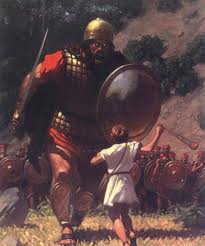
Genesis 10:14 says that the Philistines came from the Caphtorites. We know of at least 5 giants that came from the Philistines: Goliath and his four brothers. And from the description of Goliath, he was a “runt” as far as giants go – standing at a mere 9 to 12 feet in height according to some scholars. He and his brothers were the last of the giants (in the land of Canaan anyway) by the time of David.
Watch Perry Stone’s series on giants for some more extremely interesting insights about Goliath.
Let’s look a little deeper into the man named Caphtor. In Genesis 10:14, the Caphtorites are said to have fathered the Philistines. According to Jeremiah 47:4 and Amos 9:7, the Philistines came from Crete – a place described in some translations as “the country of Caphtor” because that’s where he settled at some point following the Flood. Why is this so significant? Crete is where ALL of Greek mythology came from!!
The mythology of the infamous Greek gods can literally be traced back to sometime just after the Great Flood of Noah. These gods came from Crete. Further, if you study the history of Crete, you will find that most of what we now call “Europe” used to have to pay tribute to this tiny island in the Aegean Sea. They had to send young virgin men and women to the Minotaur of the Labyrinth as tribute to King Minos. How so much of Europe could have been held in subjugation to such a tiny island doesn’t really make sense, unless you realize that the gods of antiquity likely really did exist. The Bible tells us who they really were and where they actually came from. These are the post-Flood Nephilim who sprung up through the lineage of Ham.
Finally, let’s look at Ham’s son, Cush. Scripture says that Cush begat Nimrod.
The Man of Many Names
Without a doubt, the first blatantly anti-Christ-like figure that we read about in scripture is someone the Bible refers to as Nimrod. This individual is very significant for a lot of reasons which will become apparent by the end of this blog. I believe Nimrod was a giant like so many of his cousins. Let’s look at the Hebrew (for Genesis 10:8):
The name ‘Nimrod’ (Strong’s # 5248) is a word that both Strong’s and the NAS Exhaustive Concordances say is “from foreign origin.” In his Genesis 1-15, Word Biblical Commentary, Wenham notes that the name means ‘we shall rebel’ though he admits that the etymology is by no means certain. But most scholars seem to agree that the name essentially means, “the rebellious one.” Therefore, it was probably more of a title than a proper name. That being said, I believe he has gone by many other proper names, described by many cultures of antiquity. Before I get into that, I want to address the phrase, “began to be a mighty one” first.
The word “began” used here is the word “he-hel” or “chalal” in Hebrew. Strong’s (# 2490) defines it as:
- begin men began, defile, break, defile, eat as common things
- A primitive root (compare chalah); properly, to bore, i.e. (by implication) to wound, to dissolve; figuratively, to profane (a person, place or thing), to break (one’s word), to begin (as if by an “opening wedge”); denom. (from chaliyl) to play (the flute) — begin (X men began), defile, X break, defile, X eat (as common things), X first, X gather the grape thereof, X take inheritance, pipe, player on instruments, pollute, (cast as) profane (self), prostitute, slay (slain), sorrow, stain, wound.
This is extremely interesting. Now let’s look at the word translated as “mighty one” to see just how interesting it really is. The word translated as “mighty one” is “gibbor” in Hebrew (Strong’s # 1368). There has been some debate regarding this word as it can be used in a variety of ways. Here are a few mentioned in Strong’s:
- champion, chief, excel, giant, man, mighty man, one, strong man,
Notice one of the ways that it can be used includes the word “giant” though this word is not as popular in that regard as other Hebrew words such as Nephilim or Raphaim. This word “gibbor” seems to be more of a description of a man who is indeed mighty in the sense of a warrior. But when you look at Genesis 6:4, there appears to be an interesting connection.
“There were giants [Nephilim] in the earth in those days and also after that when the sons of God came in unto the daughters of men and they bare children to them the same became mighty men [gibbor] which were of old men of renown.”
This seems to be saying that the “gibbor” can be considered the offspring of the Nephilim, which we know were giants. This is not always the case though. Take David’s “mighty men [gibbor] of valor” (in 2 Chronicles 25:6) for instance. I don’t believe these were Nephilim offspring – especially since one of the things these guys did was hunt down giants! So, we can’t get overly dogmatic about the word itself. I believe its meaning must be taken in context with its usage in the sentence.
So, what are we to think concerning Nimrod? I believe given what we know concerning the other son’s of Ham and their offspring, it is reasonable to assume that through profaning/defiling himself, Nimrod became a “mighty one” – in the sense of being an offspring of the Nephilim. What we don’t see in scripture I believe can certainly be derived from the writings of other cultures concerning this man.
In his book, The Giza Discovery, author Peter Goodgame has done a masterful job of laying the foundation of who this guy was to the ancient world… and who he will be in the days ahead. The Bible calls him Nimrod, but to the ancients he was known as:
There are others, but I primarily want to focus on the first and the last in the list above. Before I do that, I’d like to explain why he is known by so many names.
The Bible tells us about one of the things Nimrod did that made him famous. He was the one who orchestrated the building of the Tower of Babel. According to the Book of Jasher, Nimrod led a team of three camps, each with a special mission to accomplish with the completion of the Tower. One camp intended to kill God. Another intended to strike Him with bows and spears. The third planned to set up their false gods and worship them in Heaven. So what we see here are the attributes of the first Anti-Christ. He wanted to kill God and set up a One World System, with himself as God. But when God saw all that they intended to do, He decided to do something about it.
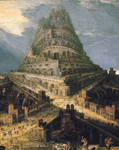 The first thing we must realize is that the Tower of Babel was not just a tall building. God didn’t freak out when we built the World Trade Center buildings. No. Nimrod was building what we might call a “Stargate” today. The Tower of Babel was literally a portal through which Nimrod intended to reach into Heaven. And apparently, this was possible.
The first thing we must realize is that the Tower of Babel was not just a tall building. God didn’t freak out when we built the World Trade Center buildings. No. Nimrod was building what we might call a “Stargate” today. The Tower of Babel was literally a portal through which Nimrod intended to reach into Heaven. And apparently, this was possible.
And they said, Go to, let us build us a city and a tower, whose top may reach unto heaven; and let us make us a name, lest we be scattered abroad upon the face of the whole earth. And the LORD came down to see the city and the tower, which the children of men builded. And the LORD said, Behold, the people is one, and they have all one language; and this they begin to do: and now nothing will be restrained from them, which they have imagined to do. Go to, let us go down, and there confound their language, that they may not understand one another’s speech. – Genesis 11:4-7 (KJV)
From that text it would seem that Nimrod’s plan was possible – at least in the sense of “reaching into Heaven.” We know that we can’t build a building that is high enough to literally enter into the “Third Heaven” where God dwells, therefore something else must be meant by this. Somehow, Nimrod and his people created something that could “bridge” our world and that of the Heavenly realm. But God put a stop to it. He confounded their speech and separated the people of the earth.
In the New Living Translation, Deuteronomy 32:8 says,
When the Most High assigned lands to the nations, when he divided up the human race, he established the boundaries of the peoples according to the number in his heavenly court.
I chose that translation, because it seems to be more accurate than most other translations that render the last part as, “according to the children of Israel.” The NLT seems to draw its translation of this verse from the Septuagint which says, “according to the angels of God.” In Barne’s Notes on the Bible, the author writes,
“Some texts of the Greek version have “according to the number of the Angels of God;” following apparently not a different reading, but the Jewish notion that the nations of the earth are seventy in number (compare Genesis 10:1 note), and that each has its own guardian Angel (compare Ecclus. 17:17). This was possibly suggested by an apprehension that the literal rendering might prove invidious to the many Gentiles who would read the Greek version.”
King Wells, the author of Ancient Myths and the Bible reinforces this belief on pages 12 and 13 of his book:
- Remember, we must prove a thesis from more than one source, so let’s look at Deut. 4:19:
And lest thou lift up thine eyes unto heaven, and when thou seest the sun, and the moon, and the stars, even all the host of heaven, shouldest be driven to worship them, and serve them, which the LORD thy God hath divided unto all nations under the whole heaven.
- Once again, we see that God divided the nations according to the host of heaven, and throughout the scriptures the host of heaven has referred to the angels…
The Book of Jasher confirms this idea as well. In chapter 48:43, it describes the throne of Pharaoh as follows.
And the throne on which the king sat was covered with gold and silver and onyx stones, and it had seventy steps.
The narrative goes on to describe the reasons for the seventy steps, stating that they represent the 70 languages of man. Note verses 45b-47:
Also any man who understood to speak in all the seventy languages, he ascended the seventy steps, and went up and spoke till he reached the king. And any man who could not complete the seventy, he ascended as many steps as the languages which he knew to speak in. It was customary in those days in Egypt that no one should reign over them, but one who understood to speak in the seventy languages.
In the next chapter (of Jasher), we see in the account of Joseph being made second in charge of Egypt, that Pharaoh’s officers protested the idea of someone ruling over them who did not know all 70 languages. This would have presented a problem for Joseph if it were not for an angel of the Lord coming to him that night and teaching him all 70 languages (Jasher 49:9-18).
What’s the point? The point is simply this: after the confusion of the tongues at the Tower of Babel, men went away talking about the same guy (Nimrod), only now in their new language. Thus Nimrod, the great and mighty warrior-hunter-god-king, became known by many different names throughout the world. With 70 different nations/languages coming out of that one event, it is now easy to understand how Nimrod could be known by at least 70 different names!
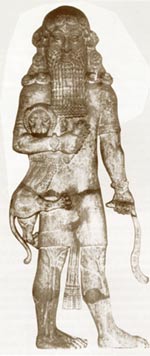 Earlier, I said I wanted to focus on two names in particular; Gilgamesh and Osiris. Let’s start with Gilgamesh. The Epic of Gilgamesh is one of the oldest stories ever written. Many people have made the connection that Gilgamesh is just one of many names for Nimrod. David Livingston does a good job of making the Nimrod-Gilgamesh connection, and the Internet is literally loaded with information and resources that testify to the two names representing the same individual.
Earlier, I said I wanted to focus on two names in particular; Gilgamesh and Osiris. Let’s start with Gilgamesh. The Epic of Gilgamesh is one of the oldest stories ever written. Many people have made the connection that Gilgamesh is just one of many names for Nimrod. David Livingston does a good job of making the Nimrod-Gilgamesh connection, and the Internet is literally loaded with information and resources that testify to the two names representing the same individual.
He is often depicted as a giant. We can see in the picture to the left that he is holding a lion under his arm! The ancient text also makes the statement that he was “2/3 god and 1/3 man.” This would certainly seem to support the “Nephilim genetics” case I’m making regarding the children of Ham.
There is much I could write about concerning Gilgamesh, but that’s all I will focus on for now. I will return to this character again shortly. Now, let’s turn our attention to Osiris.
Osiris is a VERY well known character in both history and mythology. He plays a prominent role in secret societies and even in our own government. But more than that, I believe he is the central character we need to look at when it comes to understanding the times we live in and what is to come in the near future.
For instance, did you know that Osiris is the only other god of antiquity apart from Yeshua that was known as, “The King of kings and Lord of lords?”
“…he is exceedingly mighty and most terrible in his name ‘Osiris’; he endureth for ever and for ever in his name of ‘Un-nefer.’ Homage be to thee, O King of kings, Lord of lords, Ruler of princes, who from the womb of Nut hast ruled the world and the Underworld…” – Excerpt from a Hymn to Osiris in the Book of the Dead
As stated above, Peter Goodgame has done an amazing job of connecting the dots and explaining the Osiris myth, so I won’t go over it all here. Please take the time to read Part 2 ofThe Giza Discovery to learn more. There are however a few things that I would like to point out here in order to set the stage for some of the conclusions I will draw later.
Osiris’ symbol is the ankh, which looks remarkably like a cross. One dominant theory is that the “loop” at the top of the ankh represents resurrection – as in the rebirth of the sun. This would seem to go along with the NUMEROUS dying and resurrecting sun gods born on December 25th that are found in the ancient world. And suffice it to say, it is not by chance, coincidence or accident that the Son of God was crucified on the symbol of the sun god!
With that in mind, I feel it is important to note that in Nimrod’s incarnation as Osiris, you can truly see a mirror (reversed) image of Jesus. Where Jesus is the Son of God, the Christ, the Messiah, Osiris is the exact antithesis. He is the sun god, the false messiah, the ANTI-Christ! This is one of the primary reasons why I believe Christians should have absolutely nothing to do with associating Jesus Christ and the date, December 25th. It was NOT Jesus’ birthday. It was the birthday of Nimrod/Osiris/Baal/Mithra.
It is not my intent to build a comprehensive case against Christmas in this blog. The bottom line is, in Deuteronomy 18:9, God told the Israelites not to have anything to do with the traditions of other (false) gods. He considers that an abomination. And if our God is “the same yesterday, today and forever” as the Bible claims He is, then I suspect the Word that became flesh on our behalf would give us the same warning. It has been my experience that few if any Christians want to hear this message and will fight you tooth and nail over it. But because I believe I have been shown this truth, I have a responsibility to herald it.
Once again a message came to me from the Lord: “Son of man, give your people this message: ‘When I bring an army against a country, the people of that land choose one of their own to be a watchman. When the watchman sees the enemy coming, he sounds the alarm to warn the people. Then if those who hear the alarm refuse to take action, it is their own fault if they die. They heard the alarm but ignored it, so the responsibility is theirs. If they had listened to the warning, they could have saved their lives. But if the watchman sees the enemy coming and doesn’t sound the alarm to warn the people, he is responsible for their captivity. They will die in their sins, but I will hold the watchman responsible for their deaths.’ – Ezekiel 33:1-6 (NLT)
I’ve sounded the alarm. It is up to you to heed it or ignore it. Needless to say, “Christmas Day” (as defined by December 25th) is not Jesus Christ’s birthday, but rather the birthday of the Anti-Christ – the dying and resurrecting sun god of antiquity… who hasn’t resurrected yet.
Hasn’t resurrected yet? What’s that about???
In the Book of Revelation, Jesus is repeatedly referred to as “the One who was and is and is to come.” That theme carries through the early part of the book, but once you get to chapter 13, you start to read about a “Beast” who is later described (in chapter 17:8-11) as the one who “was and is NOT and yet shall be.” More on that later.
The other thing I want to point out regarding the Osiris-Nimrod connection is their association with one of the most prominent and easily identifiable constellations in the sky – Orion. Like Gilgamesh and Nimrod, Orion is also known as “the mighty hunter.” In The Two Babylons by Alexander Hislop, the author writes the following (in Chapter 2, Death of the Child)
- Though we do not find any account of Mysteries observed in Greece in memory of Orion, the giant and mighty hunter celebrated by Homer, under that name, yet he was represented symbolically as having died in a similar way to that in which Osiris died, and as having then been translated to heaven. *
* See OVID’S Fasti. Ovid represents Orion as so puffed up with pride on account of his great strength, as vain-gloriously to boast that no creature on earth could cope with him, whereupon a scorpion appeared, “and,” says the poet, “he was added to the stars.” The name of a scorpion in Chaldee is Akrab; but Ak-rab, thus divided, signifies “THE GREAT OPPRESSOR,” and this is the hidden meaning of the Scorpion as represented in the Zodiac. That sign typifies him who cut off the Babylonian god, and suppressed the system he set up. It was while the sun was in Scorpio that Osiris in Egypt “disappeared” (WILKINSON), and great lamentations were made for his disappearance. Another subject was mixed up with the death of the Egyptian god; but it is specially to be noticed that, as it was in consequence of a conflict with a scorpion that Orion was “added to the stars,” so it was when the scorpion was in the ascendant that Osiris “disappeared.”
- From Persian records we are expressly assured that it was Nimrod who was deified after his death by the name of Orion, and placed among the stars…
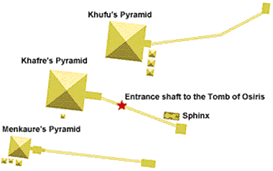 So, now that we have connected Nimrod with Gilgamesh, Osiris and Orion, I will begin to pull it all together and paint a picture that I believe perfectly illustrates what is to come.
So, now that we have connected Nimrod with Gilgamesh, Osiris and Orion, I will begin to pull it all together and paint a picture that I believe perfectly illustrates what is to come.
Everyone knows the Giza plateau is aligned to the “belt” of the Orion Constellation. The Giza plateau has received a lot of attention throughout history, but never as much as I believe it is now and will in the very near future. In 1999, Zahi Hawass, the current Secretary General of Egypt’s Supreme Council of Antiquities, claimed to have found the burial tomb of Osiris below the Giza Plateau.
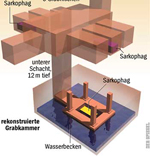 “I have found a shaft, going 29 meters vertically down into the ground, exactly halfway between the Chefren Pyramid and the Sphinx. At the bottom, which was filled with water, we have found a burial chamber with four pillars. In the middle is a large granite sarcophagus, which I expect to be the grave of Osiris, the god…I have been digging in Egypt’s sand for more than 30 years, and up to date this is the most exciting discovery I have made…. We found the shaft in November and began pumping up the water recently. So several years will pass before we have finished investigating the find.”
“I have found a shaft, going 29 meters vertically down into the ground, exactly halfway between the Chefren Pyramid and the Sphinx. At the bottom, which was filled with water, we have found a burial chamber with four pillars. In the middle is a large granite sarcophagus, which I expect to be the grave of Osiris, the god…I have been digging in Egypt’s sand for more than 30 years, and up to date this is the most exciting discovery I have made…. We found the shaft in November and began pumping up the water recently. So several years will pass before we have finished investigating the find.”
That was more than ten years ago! Just imagine what they’ve found under the Giza plateau since then!
A few years later, another astonishing (and related) discovery was made, but this time in the desert of Iraq. On Tuesday, the 29th of April, 2003, a BBC news report came out announcing that archeologists had discovered the tomb of Gilgamesh! I have copied the entire article below (because it would not surprise me if it disappears from the original BBC web site soon).
Gilgamesh tomb believed found!
Archaeologists in Iraq believe they may have found the lost tomb of King Gilgamesh – the subject of the oldest “book” in history.
Gilgamesh was believed to be two-thirds god, one-third human The Epic Of Gilgamesh – written by a Middle Eastern scholar 2,500 years before the birth of Christ – commemorated the life of the ruler of the city of Uruk, from which Iraq gets its name.
Now, a German-led expedition has discovered what is thought to be the entire city of Uruk – including, where the Euphrates once flowed, the last resting place of its famous King.
“I don’t want to say definitely it was the grave of King Gilgamesh, but it looks very similar to that described in the epic,” Jorg Fassbinder, of the Bavarian department of Historical Monuments in Munich, told the BBC World Service’s Science in Action programme.
Magnetic
In the book – actually a set of inscribed clay tablets – Gilgamesh was described as having been buried under the Euphrates, in a tomb apparently constructed when the waters of the ancient river parted following his death.
“We found just outside the city an area in the middle of the former Euphrates river the remains of such a building which could be interpreted as a burial,” Mr Fassbinder said.
Who can compare with him in kingliness? Who can say, like Gilgamesh, I am king?
The Epic Of Gilgamesh He said the amazing discovery of the ancient city under the Iraqi desert had been made possible by modern technology.
“By differences in magnetisation in the soil, you can look into the ground,” Mr Fassbinder added.
“The difference between mudbricks and sediments in the Euphrates river gives a very detailed structure.”
This creates a magnetogram, which is then digitally mapped, effectively giving a town plan of Uruk.
‘Venice in the desert’
Iraq has long been the site of some of the most important historical finds “The most surprising thing was that we found structures already described by Gilgamesh,” Mr Fassbinder stated.
“We covered more than 100 hectares. We have found garden structures and field structures as described in the epic, and we found Babylonian houses.”
But he said the most astonishing find was an incredibly sophisticated system of canals.
“Very clearly, we can see in the canals some structures showing that flooding destroyed some houses, which means it was a highly developed system.
“[It was] like Venice in the desert.”
I believe these two incredible discoveries – the tombs of Osiris and Gilgamesh – telegraph the beginning of the End.
Continue this series under the “Corruption” study menu.
